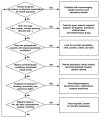Shedding light on photophobia
- PMID: 22330853
- PMCID: PMC3485070
- DOI: 10.1097/WNO.0b013e3182474548
Shedding light on photophobia
Abstract
Photophobia is a common yet debilitating symptom seen in many ophthalmic and neurologic disorders. Despite its prevalence, it is poorly understood and difficult to treat. However, the past few years have seen significant advances in our understanding of this symptom. We review the clinical characteristics and disorders associated with photophobia, discuss the anatomy and physiology of this phenomenon, and conclude with a practical approach to diagnosis and treatment.
Conflict of interest statement
Conflict of interest statement: The authors report no conflicts of interest.
Figures


Comment in
-
Relief of refractory photo-oculodynia with botulinum toxin.J Neuroophthalmol. 2012 Sep;32(3):293. doi: 10.1097/WNO.0b013e3182585b5d. J Neuroophthalmol. 2012. PMID: 22549562 No abstract available.
References
-
- Classification and diagnostic criteria for headache disorders, cranial neuralgias and facial pain. Headache Classification Committee of the International Headache Society. Cephalalgia. 1988;8 (Suppl 7):1–96. - PubMed
-
- Headache Classification Committee of the International Headache Society. The International Classification of Headache Disorders. Cephalalgia. 2004;24:1–160. - PubMed
-
- Trobe JD. Photophobia in anterior visual pathway disease. J Neuroophthalmol. 2002;22:1–2. - PubMed
-
- Webster’s New World Dictionary. Cleveland: The World Publishing Company; 1968.
-
- Lebensohn J. The nature of photophobia. Arch Ophthalmol. 1934;12:380–383.
Publication types
MeSH terms
Grants and funding
LinkOut - more resources
Full Text Sources
Other Literature Sources
Medical
Miscellaneous

